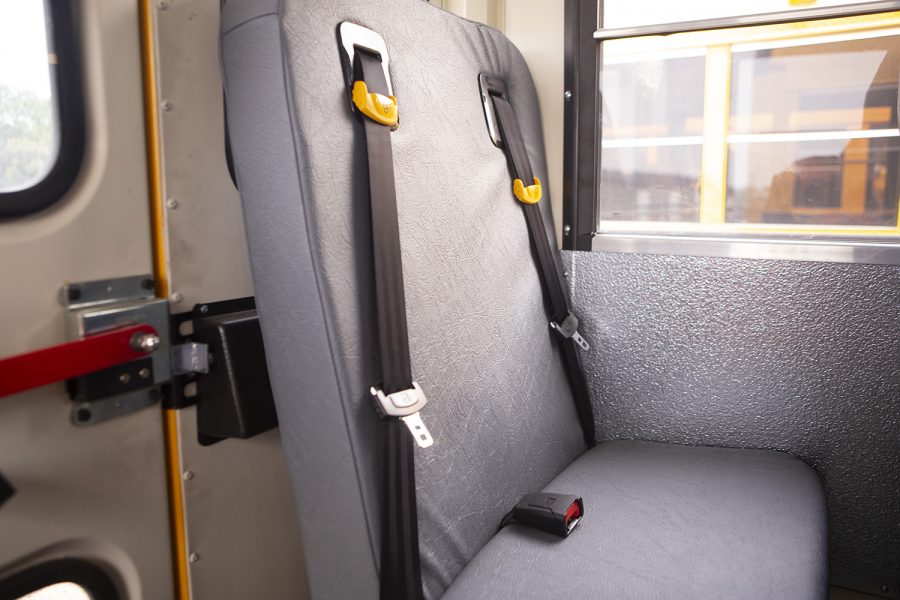Iowa legislation requiring seat belts on new school buses approved by State Department of Education
Seat belts are now required in all newly manufactured school buses across the state of Iowa after a successful proposal from education officials received approval.
A seatbelt is seen on an Iowa City Community Schools bus on Wednesday, Sept. 18, 2019.
September 23, 2019
A recent piece of state legislation is taking an extra safety measure for students by requiring seat belts on all newly manufactured school buses in Iowa.
Executive Director of the Iowa Pupil Transportation Association Chris Darling said Iowa will become the ninth state in the nation to mandate school-bus seat belts when the legislation takes effect Oct. 2.
Staci Hupp, spokesperson for the Iowa Department of Education, said safety drills will address concerns expressed by many people about the implementation of this law.
“Evacuation drills are mandated twice a year for anyone that rides the bus, and with the new rule in place those drills will cover evacuation with seat belts,” Hupp said.
The addition of seat belts will cost $8,000 per bus, which costs between $90,000 or $100,000 total, Hupp said. She added that, considering the average school bus in Iowa will run for 15 years, the costs average out to about four cents per child each day.
“The approach on this is really to allow districts to plan ahead and budget [for] changes,” Hupp said.
Max Christensen, a member of the Iowa Department of Transportation’s School Transportation Advisory Group, said he believes the additional costs are justified.
“Anytime you increase the costs of school buses it’s a concern, because if you’re spending money on buses you’re possibly taking money away from the classroom,” Christensen said. “But we felt the safety benefits certainly out-weighed those concerns.”
Christensen said that very few parents objected to the rule change.
RELATED: School board re-ups on busing plan
“Many parents I spoke with were 100 percent in favor of it,” Christensen said. “The main group of people who were concerned about [the law] were the bus drivers.”
He said the bus drivers’ concerns revolved around their own liability to buckle children in.
“I believe once they actually start using buses with lap-shoulder belts, a lot of those concerns are going to dissipate,” Christensen said.
On July 15, Darling said the Iowa Pupil Transportation Association held a conference for various directors of transportation, superintendents, mechanics, and drivers. He added that 241 people attended the conference this summer, and nearly all 99 Iowa counties were represented.
At the conference, the association demonstrated the effectiveness of seat belts in school buses through a simulated crash with crash dummies following a meeting with state legislators.
The results of the crash test, in which a 40 mph collision sent the bus airborne, were clear to the researchers.
RELATED: Child auto-safety rises
“The crash dummies that were in seat belts stayed in their seats, and the crash dummies that weren’t ended up on the floor,” he said.
Writing the regulation into law was a long process, Darling said. Public opinion had to change over the course of several years, particularly in regards to compartmentalization — the idea that packing children into seats with some padding is the safest method.
“First of all, you have to change the way everyone thinks,” Darling said. “For years, we’ve been told that compartmentalization works. That’s something that has been preached since I started in the early ‘80s.”
Darling added that some states use lap seat belts, but lap-shoulder belts are safer due to the increased likelihood of abdominal injuries in lap-only belts.
“One of the battles that bus drivers have every day is keeping students in their seats,” Darling said. “With the seat belts, they should be able to keep students in their seats with the mandatory requirement that they have to wear them. This should help with bullying, too.”






